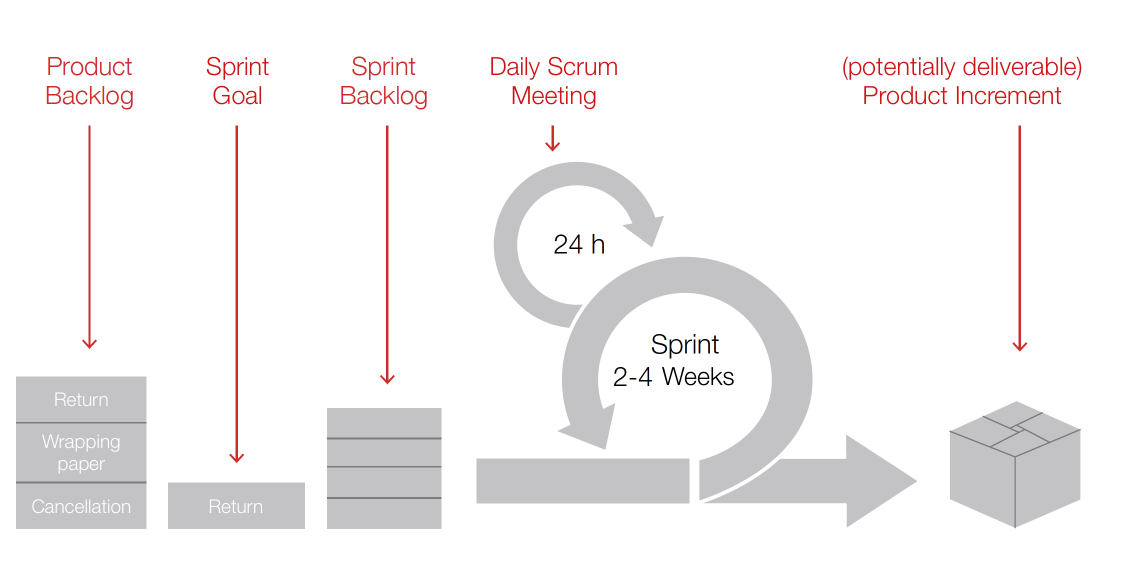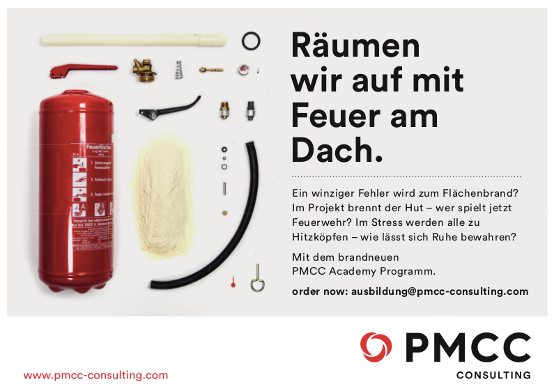Scrum – the Process
Scrum is an incremental, iterative development method. The development is organized step by step by a self-organized, self-managed team in fixed cycles (sprints). A consistent sprint length (about 2-4 weeks) gives the team a rhythm. The goal is to have a potentially deliverable product increment at the end of each sprint, a fully finished (partial) result that can potentially be used productively. The idea behind this is that results can be delivered faster and that (in late project phases) it is still possible to respond flexibly to (new) customer requests or changes in general.
The central element of Scrum is the sprint: At the beginning of each sprint is the so-called Product Backlog, a list of prioritized requirements. Out of that, the development team takes as many tasks (requirements) according to their priority as has typically proven feasible in one sprint. These requirements are not modified by additional ones during the ongoing sprint, so as not to jeopardize their completion. During the sprint, the team works in a concentrated and non-disruptive manner to translate the defined tasks into a potentially deliverable product increment. At the end of the sprint, this will be presented to the customer (and potential stakeholders) and, ideally, released by them. Potential customer feedback - as well as the team's experience - flow into the next sprint planning, and the process begins again again (see figure 1).
Scrum defines just a few cornerstones for the approach, which is why it is often referred to as a framework. At the core are three roles, three artefacts (result types) and four events.
The idea of Scrum is that results can be delivered faster and (in late project phases) it is still possible to respond flexibly to (new) customer requests or changes in general.
Scrum Roles
- The Product Owner sets technical requirements, prioritizes them and at the end of each sprint releases the implementation of the requirements.
- The Scrum Master removes obstacles, he is responsible for ensuring that the team can work operationally and productively.
- The Development Team organizes itself and is responsible for achieving the sprint goals.
Scrum Artifacts
- The Product Backlog is a list of customer requirements that are prioritized by importance.
- The Sprint Backlog contains the activities that must be performed to implement the customer requirements of the sprint.
- The Product Increment is the partial product that has been created at the end of a sprint.
Scrum Events
- In Sprint Planning, for each sprint all those requirements are determined that are implemented in it and for which detailed planning is performed.
- In the Daily Scrum the status of the sprint is briefly discussed with each team member answering 3 questions: "What did I do yesterday?", "What am I doing today?" and "What is stopping me?”
- The Sprint Review introduces the “potentially shippable product” and seeks user feedback to make the product better.
- The Sprint Retrospective deals with the working methods in the last sprint and with measures that can improve the work in the next sprint.
- The Product Backlog Refinement is not a classic Scrum event, but a valuable process as a continuous activity. This includes adding details, estimations and prioritizing user stories (customer requirements) in the product backlog.
Hence, Scrum is an excellent approach for designing a project environment with continuously changing or only just developing requirements, e.g. implementing product, process or organizational developments in a customer-oriented and designable way. At the same time, it is a showcase model for team empowerment, for the strong integration of the customer perspective, for the importance of well-organized communication and clearly defined (and lived) rules of the game.







 Jira
Jira
 Confluence
Confluence
 SAP
SAP
 API
API





